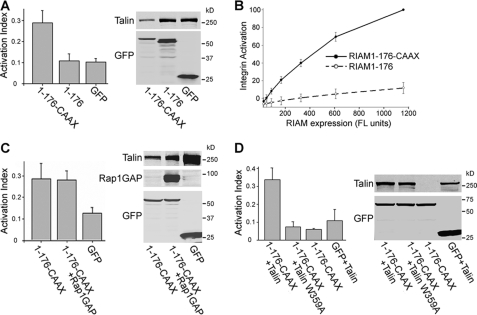FIGURE 3.
Tethering membrane targeting sequences of Rap1 to RIAM-(1–176) bypasses Rap1 requirement for integrin activation. A5 cells were co-transfected with HA-talin and GFP-tagged RIAM-(1–176) constructs with or without Rap1GAP, as indicated. Integrin activation was assayed by PAC1 binding and quantified using flow cytometry as described in Fig. 2. A, fusion of the membrane targeting sequences of Rap1 with RIAM-(1–176) to form RIAM-(1–176)-CAAX induced integrin activation. B, the extent of integrin activation (Activation index), calculated as described in legend to Fig. 2B, was plotted against expression of RIAM-(1–176) or RIAM-(1–176)-CAAX as assessed by GFP fluorescence intensity. C, integrin activation induced by RIAM-(1–176)-CAAX was insensitive to inhibition by Rap1GAP co-expression. D, integrin activation depends on talin binding to the integrin because it is abolished with HA-talin (W359A), a mutant talin that is deficient in binding to the integrin β3 cytoplasmic tail. Integrin activation indices were calculated as described in Fig. 2 and are the mean ± S.E. for n ≥ 3(A–D). Transfected protein expression levels were assessed by Western blotting (right panels) with antibodies against GFP or HA for detection of GFP-RIAM, HA-talin, or HA-Rap1GAP, as indicated (A–D).

